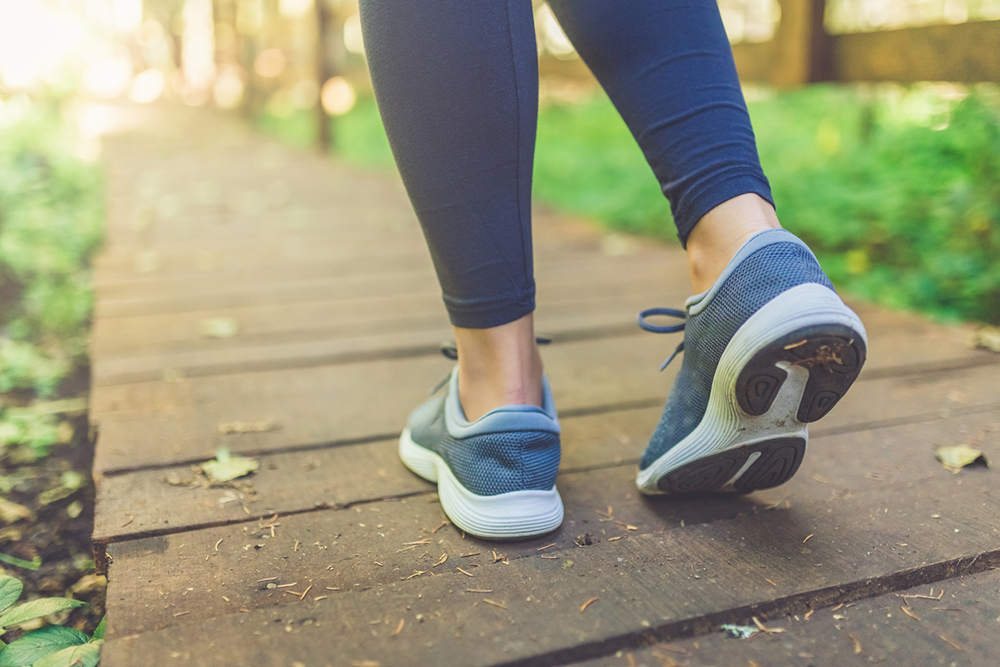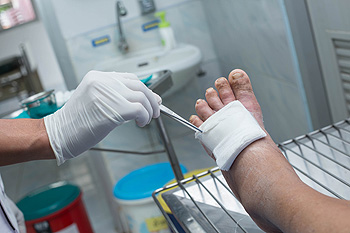Items filtered by date: January 2025
Understanding the Brannock Device

Wearing shoes that do not fit correctly can lead to a variety of foot problems. Ill-fitting shoes can cause blisters, corns, calluses, bunions, and even more severe conditions like plantar fasciitis or nerve damage. Shoes that are too tight can compress the toes, while shoes that are too loose may cause the feet to slide around, leading to friction and discomfort. To avoid these issues, it is essential to measure your feet accurately to find the right shoe size. One of the best ways to do this is by using a Brannock device, a tool designed to measure both the length and width of the foot. By placing your foot on the device, you can obtain an accurate reading of your foot size, ensuring a more comfortable and supportive fit. Properly fitting shoes can improve overall foot health and help prevent long-term damage or pain. If you have foot pain from wearing shoes that do not fit correctly, it is suggested that you contact a podiatrist who can offer relief tips, and provide additional guidance on choosing shoes that fit properly.
Getting the right shoe size is an important part of proper foot health. Seek the assistance of David K. Morris, DPM from Florida. Our doctor will provide the care you need to keep you pain-free and on your feet.
Getting the Right Shoe Size
There are many people who wear shoes that are the incorrect size, negatively affecting their feet and posture. Selecting the right shoes is not a difficult process, so long as you keep several things in mind when it comes to choosing the right pair.
- When visiting the shoe store, use the tools available to measure your foot.
- Be sure there is ‘wiggle room’. There should be about an inch between your toes and the tip of your shoes.
- Do not always assume you are the same size, as manufacturers run differently.
- Purchase shoes later in the day, as your feet swell as the day progresses.
- If a shoe is not comfortable, it is not suitable. Most shoes can’t be ‘broken in’, and comfort should be the ultimate goal when it comes to choosing the right pair of shoes
As our feet hold our body weight and keep us moving, it is important to treat them right. Picking the right pair of shoes can provide your feet comfort and mobility without pain.
If you have any questions, please feel free to contact our office located in Plantation, FL . We offer the newest diagnostic and treatment technologies for all your foot care needs.
Do Your Child's Feet Hurt?
Walking and Running Shoes and Their Impact on the Feet

Walking and running shoes are designed to meet the specific demands placed on the feet during each activity. Walking shoes typically have a more flexible sole to accommodate the natural rolling motion of the foot as it strikes the ground. They offer cushioning in the heel and arch to provide comfort during prolonged periods of walking. In contrast, running shoes are built to handle the higher impact and repetitive force that running creates. They feature more advanced cushioning, especially in the heel and forefoot, to absorb shock and reduce strain on the joints. Running shoes also offer more support in the midsole to help stabilize the foot during high-impact activities. While walking shoes focus on comfort and support for slower, low-impact movements, running shoes are engineered to provide durability and protection for the faster, more intense demands of running. If you have sustained a foot injury from wearing the wrong shoes for your desired sport, it is suggested that you visit a podiatrist who can treat various foot conditions, and educate you on appropriate shoes to wear.
For more information about walking shoes versus running shoes, consult with David K. Morris, DPM from Florida. Our doctor can measure your feet to determine what your needs are and help you find an appropriate pair of footwear.
Foot Health: The Differences between Walking & Running Shoes
There are great ways to stay in shape: running and walking are two great exercises to a healthy lifestyle. It is important to know that running shoes and walking shoes are not interchangeable. There is a key difference on how the feet hit the ground when someone is running or walking. This is why one should be aware that a shoe is designed differently for each activity.
You may be asking yourself what the real differences are between walking and running shoes and the answers may shock you.
Differences
Walking doesn’t involve as much stress or impact on the feet as running does. However, this doesn’t mean that you should be any less prepared. When you’re walking, you land on your heels and have your foot roll forward. This rolling motion requires additional support to the feet.
Flexibility – Walking shoes are designed to have soft, flexible soles. This allows the walker to push off easily with each step.
If you have any questions, please feel free to contact our office located in Plantation, FL . We offer the newest diagnostic and treatment technologies for all your foot care needs.
Treating Diabetic Foot Ulcers

Diabetic foot ulcers can be a significant complication for people with diabetes due to reduced sensation and poor circulation in the feet. These ulcers often develop from minor injuries or pressure points that go unnoticed, as decreased nerve function can mask pain, and poor circulation inhibits healing. A podiatrist plays an essential role in diagnosing and managing foot ulcers to prevent serious infections. Treatment typically includes debridement, which involves removing dead or infected tissue to clean the wound and stimulate recovery. A podiatrist will also assess the depth and severity of the ulcer, ensuring that no foreign materials are present. Protective measures, such as specialized footwear or casts, may be recommended to reduce pressure on the affected area. Regular wound care, including cleaning and dressing changes, further supports recovery. Maintaining controlled blood sugar levels is vital, as it aids in faster healing and reduces the risk of infection. If you have foot ulcers as a result of diabetes, it is suggested that you schedule regular appointments with a podiatrist.
Diabetic foot care is important in preventing foot ailments such as ulcers. If you are suffering from diabetes or have any other concerns about your feet, contact David K. Morris, DPM from Florida. Our doctor can provide the care you need to keep you pain-free and on your feet.
Diabetic Foot Care
Diabetes affects millions of people every year. The condition can damage blood vessels in many parts of the body, especially the feet. Because of this, taking care of your feet is essential if you have diabetes, and having a podiatrist help monitor your foot health is highly recommended.
The Importance of Caring for Your Feet
- Routinely inspect your feet for bruises or sores.
- Wear socks that fit your feet comfortably.
- Wear comfortable shoes that provide adequate support.
Patients with diabetes should have their doctor monitor their blood levels, as blood sugar levels play such a huge role in diabetic care. Monitoring these levels on a regular basis is highly advised.
It is always best to inform your healthcare professional of any concerns you may have regarding your feet, especially for diabetic patients. Early treatment and routine foot examinations are keys to maintaining proper health, especially because severe complications can arise if proper treatment is not applied.
If you have any questions please feel free to contact our office located in Plantation, FL . We offer the newest diagnostic and treatment technologies for all your foot and ankle needs.
How to Handle a Broken Toe That Does Not Heal

A broken toe that does not heal can be a frustrating and painful experience. If you have noticed persistent pain, swelling, or difficulty moving the toe despite following basic treatment guidelines, it may be time to consult a podiatrist. A non-healing fracture could indicate a more serious issue, such as improper alignment, insufficient rest, or an underlying health condition like osteoporosis. A podiatrist may recommend additional treatments such as immobilization with a special shoe or splint, or surgery to realign the bones properly. Specific stretches may also be suggested to restore strength and flexibility. If you have a broken toe or continue to be uncomfortable, it is suggested that you consult a podiatrist who can provide appropriate treatment solutions.
A broken toe can be very painful and lead to complications if not properly fixed. If you have any concerns about your feet, contact David K. Morris, DPM from Florida. Our doctor will treat your foot and ankle needs.
What to Know About a Broken Toe
Although most people try to avoid foot trauma such as banging, stubbing, or dropping heavy objects on their feet, the unfortunate fact is that it is a common occurrence. Given the fact that toes are positioned in front of the feet, they typically sustain the brunt of such trauma. When trauma occurs to a toe, the result can be a painful break (fracture).
Symptoms of a Broken Toe
- Throbbing pain
- Swelling
- Bruising on the skin and toenail
- The inability to move the toe
- Toe appears crooked or disfigured
- Tingling or numbness in the toe
Generally, it is best to stay off of the injured toe with the affected foot elevated.
Severe toe fractures may be treated with a splint, cast, and in some cases, minor surgery. Due to its position and the pressure it endures with daily activity, future complications can occur if the big toe is not properly treated.
If you have any questions please feel free to contact our office located in Plantation, FL . We offer the newest diagnostic and treatment technologies for all your foot and ankle needs.




